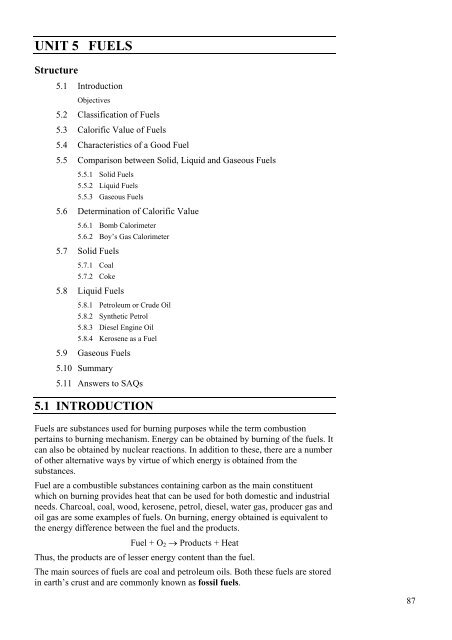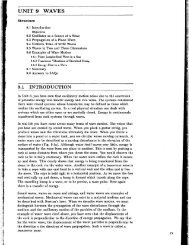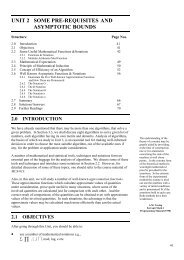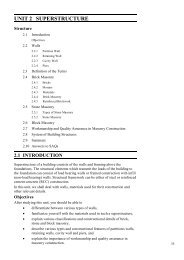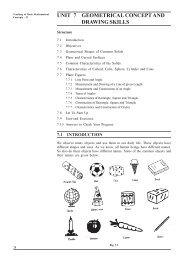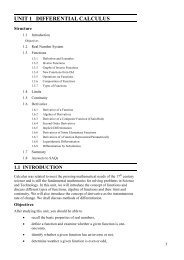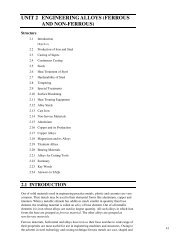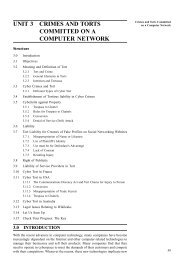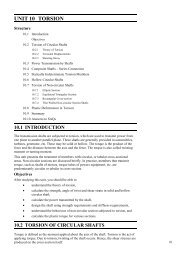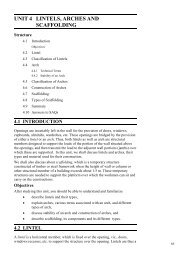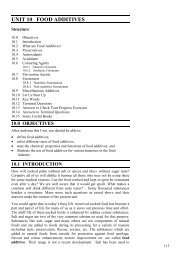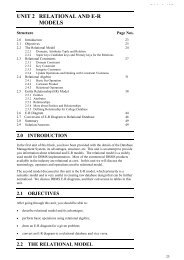Fuels - IGNOU
Fuels - IGNOU
Fuels - IGNOU
You also want an ePaper? Increase the reach of your titles
YUMPU automatically turns print PDFs into web optimized ePapers that Google loves.
UNIT 5 FUELS<br />
Structure<br />
5.1 Introduction<br />
Objectives<br />
5.2 Classification of <strong>Fuels</strong><br />
5.3 Calorific Value of <strong>Fuels</strong><br />
5.4 Characteristics of a Good Fuel<br />
5.5 Comparison between Solid, Liquid and Gaseous <strong>Fuels</strong><br />
5.5.1 Solid <strong>Fuels</strong><br />
5.5.2 Liquid <strong>Fuels</strong><br />
5.5.3 Gaseous <strong>Fuels</strong><br />
5.6 Determination of Calorific Value<br />
5.6.1 Bomb Calorimeter<br />
5.6.2 Boy’s Gas Calorimeter<br />
5.7 Solid <strong>Fuels</strong><br />
5.7.1 Coal<br />
5.7.2 Coke<br />
5.8 Liquid <strong>Fuels</strong><br />
5.8.1 Petroleum or Crude Oil<br />
5.8.2 Synthetic Petrol<br />
5.8.3 Diesel Engine Oil<br />
5.8.4 Kerosene as a Fuel<br />
5.9 Gaseous <strong>Fuels</strong><br />
5.10 Summary<br />
5.11 Answers to SAQs<br />
5.1 INTRODUCTION<br />
<strong>Fuels</strong> are substances used for burning purposes while the term combustion<br />
pertains to burning mechanism. Energy can be obtained by burning of the fuels. It<br />
can also be obtained by nuclear reactions. In addition to these, there are a number<br />
of other alternative ways by virtue of which energy is obtained from the<br />
substances.<br />
Fuel are a combustible substances containing carbon as the main constituent<br />
which on burning provides heat that can be used for both domestic and industrial<br />
needs. Charcoal, coal, wood, kerosene, petrol, diesel, water gas, producer gas and<br />
oil gas are some examples of fuels. On burning, energy obtained is equivalent to<br />
the energy difference between the fuel and the products.<br />
Fuel + O2 → Products + Heat<br />
Thus, the products are of lesser energy content than the fuel.<br />
The main sources of fuels are coal and petroleum oils. Both these fuels are stored<br />
in earth’s crust and are commonly known as fossil fuels.<br />
<strong>Fuels</strong><br />
87
Chemistry<br />
88<br />
In this unit, we will first discuss the classification of fuels. Then the calorific<br />
value of a fuel would be explained. We would then list the characteristics of a<br />
good fuel. This would be followed by discussion on the determination of calorific<br />
value. Finally, we would explain in detail some solid, liquid and gaseous fuels.<br />
Objectives<br />
After studying this unit, you should be able to<br />
• define fuels,<br />
• give the necessity of fuels in our daily life,<br />
• classify fuels as solid, liquid or gaseous,<br />
• list important characteristics of a good fuel,<br />
• explain the determination of calorific values by bomb calorimeter and<br />
Boy’s gas calorimeter,<br />
• describe the various of types solid fuels such as coals and coke,<br />
• discuss the origin, mining and refining of petroleum or crude oil,<br />
• explain liquid fuels such as synthetic petrol, diesel and kerosene, and<br />
• give composition and importance of gaseous fuels such as natural gas,<br />
water gas, coal gas, oil gas and biogas etc.<br />
5.2 CLASSIFICATION OF FUELS<br />
<strong>Fuels</strong> can be classified on the basis of their<br />
(i) occurrence, and<br />
(ii) state of aggregation.<br />
As per the first classification, they may be further divided as primary and<br />
secondary fuels. Primary fuels which are also known as natural fuels are<br />
obtained from nature as such. Their examples are coal, wood, petroleum and<br />
natural gas etc. Secondary or artificial fuels are prepared from primary fuels. The<br />
examples of secondary fuels are coke, charcoal, diesel, kerosene, producer gas<br />
and water gas.<br />
Figure 5.1 : Classification of <strong>Fuels</strong>
Primary solid fuels are available in nature and can be used as such straight away<br />
or after a minor processing like washing, cleaning or drying etc. Now-a-days,<br />
wood in general is not in practice as a source of energy unless it is available very<br />
economically. The use of wood also leads to deforestation which affects the<br />
environment. In place of wood, other materials like coke, charcoal and coal etc.<br />
are preferred. As a fuel, wood has less calorific value.<br />
Figure 5.1 summarizes the classification of fuels and their examples.<br />
5.3 CALORIFIC VALUE OF FUELS<br />
The calorific value of a fuel is defined as the amount of heat liberated when a<br />
unit mass (or volume) of the fuel is burnt completely. It is expressed in terms of<br />
unit of heat in a number of ways as follows :<br />
(i) Calorie<br />
It is the amount of heat required to raise the temperature of 1 gm of<br />
water by 1 o C (i.e., 15 o C to 16 o C).<br />
(ii) Kilo Calorie<br />
It is the unit in metric system. It is defined as the amount of the heat<br />
required to raise the temperature of 1 kg of water by 1 o C (i.e., 15 o C to<br />
16 o C).<br />
(iii) British Thermal Unit (B. Th. U)<br />
It is the amount of heat required to raise the temperature of 1 pound of<br />
water by 1 o F (i.e., 60 – 61 o F).<br />
(iv) Centigrade Heat Unit (C. H. U)<br />
1 B. Th. U. = 252 Calories<br />
1 kcal = 3.968 B. Th. U.<br />
It is the amount of heat required to raise the temperature of 1 pound of<br />
water by 1 o C (i.e., 15 o C – 16 o C)<br />
1 kcal = 3.968 B. Th. U.<br />
1 kcal = 2.2 C. H. U.<br />
In case of solid or liquid fuels, the calorific value is expressed either in terms of<br />
cal./gm or kcal/kg or B. Th. U./lb. In case of gaseous fuels, the unit of calorific<br />
value is kcal/m 3 or B. Th. U./ft 3 .<br />
The caloric values of fuels are expressed using following two terms :<br />
(i) Higher or gross calorific value, and<br />
(ii) Lower or net calorific value.<br />
Higher or Gross Calorific Value (HCV)<br />
It is concerned with the hydrogen containing fuels which on burning get<br />
converted into steam. The products of combustion get cooled down to room<br />
temperature and the latent heat of condensation is also included in<br />
calculation but in true sense HCV is the total amount of heat produced<br />
when unit mass (or volume) of the fuel is burnt completely and the products<br />
of combustion were cooled to temperature 15 o C or 60 o F.<br />
<strong>Fuels</strong><br />
89
Chemistry<br />
90<br />
Lower or Net Calorific Value (LCV)<br />
SAQ 1<br />
When any fuel is burnt, water or moisture is not condensed and it escapes<br />
along with hot combustion which means that a lesser amount of heat is<br />
available. LCV can be understood as the net amount of heat obtained on<br />
burning completely one unit mass (or volume) of fuel when the products are<br />
permitted to escape. Hence<br />
LCV = HCV – Latent Heat of water/moisture vapour formed<br />
(a) What are the units of calorific value of a fuel?<br />
(b) Differentiate between HCV and LCV.<br />
5.4 CHARACTERISTICS OF A GOOD FUEL<br />
A fuel which fullfills the following requirements is known as a good fuel.<br />
SAQ 2<br />
(i) It should have a high calorific value per unit mass or volume. It<br />
should generate large amount of heat under end use conditions.<br />
(ii) It should not evolve harmful gases or substances like COX, NOX, and<br />
SO2 etc.<br />
(iii) It should not be associated with higher amount of<br />
non-combustible materials like ash, clinker etc.<br />
(iv) It should have moderate ignition temperature. Low ignition<br />
temperature is dangerous for storage as well as transportation since it<br />
can create fire hazards. On the other hand, high ignition temperature<br />
causes difficulty in ignition.<br />
(v) It should not give any unpleasant odour.<br />
(vi) It should have moderate velocity of combustion.<br />
(vii) It should be readily available in bulk at economical rate.<br />
(viii) It should burn with efficiency without producing much smoke.<br />
(ix) In case of solid fuel, the size should be uniform so that the<br />
combustion may take place in regular way.<br />
(x) It should be easy to handle and transport.<br />
Write down five characteristics of ‘good fuel’.
5.5 COMPARISON BETWEEN SOLID, LIQUID AND<br />
GASEOUS FUELS<br />
Every fuel in its aggregation of state is associated some merits and demerits. We<br />
will now list the merits and demerits of solid, liquid and gaseous fuels.<br />
5.5.1 Solid <strong>Fuels</strong><br />
Merits<br />
(i) Their cost of production is low.<br />
(ii) They are easy to store and transport.<br />
(iii) They have high calorific value.<br />
(iv) They have moderate ignition temperature.<br />
(v) They have good adsorption for gases.<br />
Demerits<br />
(i) They have high ash content.<br />
(ii) Their thermal efficiency is low.<br />
(iii) They burn with clinker formation.<br />
(iv) They produce harmful waste products.<br />
(v) They have high moisture content but their moisture content is lower<br />
than liquid or gaseous fuels.<br />
(vi) They cannot be used as internal combustion engine fuels.<br />
(vii) A good amount of heat goes waste.<br />
(viii) Their combustion is not easily controllable.<br />
5.5.2 Liquid <strong>Fuels</strong><br />
The following are some merits and demerits of liquid fuels.<br />
Merits<br />
(i) Liquid fuels do not give any non-combustible matter after burning.<br />
(ii) They can also be used in internal combustion (IC) engines.<br />
(iii) They have moderate ignition temperature.<br />
(iv) They need less amount of air for their complete combustion.<br />
(v) They are economical.<br />
(vi) Combustion is easily controllable in case of liquid fuels.<br />
(vii) They have less moisture content.<br />
(viii) They possess high calorific value.<br />
(ix) Their supply can be easily regulated.<br />
(x) They can be easily stored for long period.<br />
Demerits<br />
(i) Their storage is costlier than solid fuels.<br />
(ii) Their cost is much higher than solid ones.<br />
(iii) They produce bad odour.<br />
(iv) There is a great risk of fire hazards with liquid fuels.<br />
(v) They are inflammable.<br />
<strong>Fuels</strong><br />
91
Chemistry<br />
92<br />
5.5.3 Gaseous <strong>Fuels</strong><br />
The following are some merits and demerits of gaseous fuels.<br />
Merits<br />
Demerits<br />
(i) Gaseous fuels can be transported easily through pipes to the place of<br />
their consumption. Thus, their transportation cost is minimized.<br />
(ii) They burn easily.<br />
(iii) Gaseous fuels leave no non-combustible matter after burning.<br />
(iv) They can be used as internal combustion engine fuels.<br />
(v) They are very economical.<br />
(vi) They have high calorific value.<br />
(vii) They burn without soot.<br />
(viii) Their combustion can easily be controlled.<br />
(ix) In case of gaseous fuels, uniform mixing with air can be carried out<br />
and hence environmental pollution can be avoided.<br />
(x) They do not need any special burners.<br />
(i) They are highly inflammable and therefore there are greater chances<br />
of fire hazards.<br />
(ii) They need more space for their storage, thereby their storage is a<br />
costly affair.<br />
5.6 DETERMINATION OF CALORIFIC VALUE<br />
The calorific values can be determined using Bomb calorimeter and Boy’s gas<br />
calorimeter. In this section you will study about them in detail.<br />
5.6.1 Bomb Calorimeter<br />
Bomb calorimeter is used to determine the calorific value of solid and liquid<br />
fuels. The apparatus is shown in Figure 5.2.<br />
Figure 5.2 : Bomb Calorimeter
Construction<br />
Function<br />
The Bomb is made of steel in which the combustion of fuel is allowed. It<br />
has a lid which can be screwed to the body of bomb so as to provide a<br />
perfect gas tight seal. The lid is provided with two stainless steel electrodes<br />
and an oxygen inlet valve. A small ring is attached to one of the electrodes.<br />
A stainless steel or nickel crucible is supported with this ring. This bomb is<br />
placed in a copper calorimeter which is surrounded by air jacket or water<br />
jacket so that no heat loss takes place due to radiation. The apparatus also<br />
contains an electrically operated stirrer and Beckman’s thermometer which<br />
gives temperature upto 1/100 th degree centigrade.<br />
A definite mass (0.5 to 1.0 g) of the fuel under testing is taken in a clean<br />
crucible. The crucible is then supported over the ring. A good quality<br />
magnesium wire touching the fuel is placed across the electrodes. The bomb<br />
is placed across the electrodes. The bombs lid is tightly screwed. The bomb<br />
is filled with oxygen and the pressure inside is created upto 25 atm. The<br />
bomb is lowered in copper calorimeter which contains a known amount of<br />
water. The initial temperature of water is recorded and then the electrodes<br />
are connected to a 6 volt battery and circuit is completed. The fuel sample<br />
burns and the heat is released. The water is stirred uniformly and the<br />
maximum temperature attained by the water is recorded.<br />
Calculations<br />
Let m = mass (in gms) of fuel sample,<br />
W = mass (in gms) of water in calorimeter,<br />
w = water equivalent (in gms) of calorimeter,<br />
t1 = initial temperature of water,<br />
t2 = final temperature of water, and<br />
L = higher calorific value (HCV) in fuel (cal/gm).<br />
Then, the total heat liberated by burning of fuel = m × L.<br />
The heat taken by water and the system = (W + w) (t2 – t1)<br />
As we know that heat liberated = heat taken, hence<br />
Heat liberated by the fuel = Heat taken by the water and system<br />
m × L = W + w)<br />
( t − t )<br />
( 2 1<br />
( W + w)<br />
( t2<br />
− t1)<br />
or L =<br />
cal/<br />
gm.<br />
m<br />
It is the HCV of the fuel taken for testing.<br />
LCV = HCV – Latent heat of water produced.<br />
The latent heat of water<br />
= 0 . 09 × 587 cal/<br />
gm<br />
(Latent heat of steam is 587 cal/gm).<br />
5.6.2 Boy’s Gas Calorimeter<br />
The calorific value of liquid and gaseous fuels can be determined by Boy’s Gas<br />
calorimeter. The apparatus is shown in Figure 5.3.<br />
<strong>Fuels</strong><br />
93
Chemistry<br />
94<br />
Figure 5.3 : Boy’s Gas Calorimeter<br />
Construction<br />
The apparatus consists of a suitable gas burner in which a known volume of<br />
gas at known pressure can undergo combustion at a uniform rate of 3-4<br />
litres per minute. Around the burner, there is a combustion chamber with a<br />
copper tubing coiled inside as well as outside. Water is passed through this<br />
coil at constant rate continuously. To determine the colorific value<br />
correctly, the whole system is kept insulated.<br />
Function<br />
A definite volume of gas is taken in the gas burner at definite pressure. The<br />
gas is burnt at constant rate to produce a large amount of heat. The rise in<br />
temperature in the water circulation is recorded accurately with the help of<br />
thermometer. When the steady situation with respect to rate of fuel burning<br />
and water circulation is attained, then the following observations are taken.<br />
(i) The volume of gas burnt in a given time<br />
(ii) The quality of water circulated through the coil<br />
(iii) Mass of water condensed during that time<br />
(iv) The rise in temperature<br />
Calculation<br />
(i) Using the above observations, we can calculate HCV and LCV of<br />
liquid fuels and gaseous fuels as follows :<br />
V = volume of gas burnt in time ‘t’.<br />
W = mass of water circulated in time ‘t’.<br />
T1 and T2 are initial and final temperatures of water, respectively.<br />
L = Higher calorific value of fuel (cal/gm)<br />
m = mass of water condensed in time ‘t’.<br />
(ii) Heat given by the combustion of fuel = V × L<br />
(iii) Heat taken by the circulated water = W T − T ) .<br />
( 2 1<br />
Assuming that there is no loss of heat, we can say that<br />
Heat given = Heat taken<br />
V × L = W T − T )<br />
W<br />
HCV =<br />
L =<br />
( 2 1<br />
( T2<br />
T1<br />
−<br />
V<br />
)
LCV = HCV – Latent heat of water produced<br />
⎛ m ⎞ 3<br />
= ⎜ L − 587⎟ Kcal/<br />
m .<br />
⎝ V ⎠<br />
5.7 SOLID FUELS<br />
We will now discuss two solids fuels, viz., coal and coke.<br />
5.7.1 Coal<br />
Coal is a highly carbonaceous matter and is used as a fuel. It is found in nature as<br />
a result of several decomposition stages of vegetable matter under the influence<br />
of heat and pressure in limited supply of air. It consists of mainly C, H, N, O and<br />
some non-combustible inorganic matter. There are several theories which predict<br />
the coal formation but out of these two main theories are :<br />
(i) Situ Theory, and<br />
(ii) Transportation Theory (Drift Theory).<br />
Situ Theory<br />
This theory hints that the coal formation took place at the place of<br />
vegetation which is known as pure form of the coal.<br />
Transportation Theory (Drift Theory)<br />
This theory hints that vegetables, trees and organic matter etc. have been<br />
undergone transportation to deep depressions which decomposed gradually<br />
under high pressure and temperature with the evolution of gases like CH4,<br />
C2H6, CO2 etc. In this way, the coal got deposited in the form of thick<br />
layers.<br />
Classification of Coal by Rank<br />
Coal is classified on the basis of following characteristics :<br />
(i) Less hydrogen, nitrogen, oxygen, sulphur contents and more<br />
carbon content<br />
(ii) Less moisture content<br />
(iii) High calorific value<br />
(iv) Moderately hard<br />
(v) Less volatile matter<br />
The successive stages of transformation of vegetable matter into coal<br />
are wood, peat, lignite, bituminous and anthracite.<br />
(i) Peat<br />
It is found as brown fibrous jelly like material. It is considered<br />
that it is the first stage of wood coalification. It is not an<br />
economical fuel. It is in practice dug by manpower. Peat variety<br />
contains 80-90% water (moisture). The average composition of<br />
air dried peat coal is as follows : C = 57%, H = 6%, O = 35%<br />
and ash content 2 to 6%. The calorific value of this coal is about<br />
5500 kcal/kg (on air dry basis). In India, it is found in Nilgiri<br />
Hills (South India).<br />
<strong>Fuels</strong><br />
95
Chemistry<br />
96<br />
(ii) Lignite<br />
It is considered as the second stage of coalfication of wood. It<br />
contains less moisture than peat coal. It is soft and brown<br />
coloured variety of coal. It is in compact texture and gets<br />
broken down in small pieces easily. In our country, it is found<br />
in Kashmir, Rajasthan, Assam and in Tamil Nadu (at Neyveli).<br />
The average composition of lignite (on air dry basis) is as<br />
C = 60 to 70%, O = 20%, H = 5% and ash = 2%. Lignite coal is<br />
a very good domestic fuel. It is mainly used in the manufacture<br />
of producer gas and in steam generation as boiler fuel. On air<br />
dry basis, its calorific value ranges between 6400-7150 kcal/kg.<br />
(iii) Bituminous Coals<br />
These coals are available in pitch blank to dark grey colours.<br />
These are good quality coals. The average composition of<br />
bituminous coals (on air dry basis) is as follows : C = 88%,<br />
H = 4.5 and O (N, S) 13.5%. Their calorific value is higher than<br />
peat and lignite coals. This value varies from 7000 to<br />
8500 kcal/kg. The bituminous coal deposits are found in<br />
Madhya Pradesh, Orissa, Bihar and West Bengal. These coals<br />
are very much used in industries, household needs and in the<br />
manufacturing of metallurgical coke and coal gas.<br />
(iv) Anthracite<br />
Selection of Coal<br />
Anthracite is the coal of the highest rank. It is considered as the<br />
purest form of the coal. It contains (on air dry basis) 92-96%<br />
carbon and has the lowest amount of volatile matter. It is the<br />
hardest form of coal and has good lustrous appearance. It gives<br />
intense local heating. It gives no smoke during burning. It<br />
provides high calorific value of 8700 kcal/kg. In India, its<br />
deposits are found in Kashmir and in eastern Himalayan region.<br />
The selection of coal is carried out on the basis of following points :<br />
(i) Calorific Value<br />
The coal should have high calorific value so that its small<br />
quantity may provide a large amount of heat. High calorific<br />
value coal reduces the cost of its transportation and storage.<br />
(ii) Coking Quality<br />
We know that coke is obtained by high carbonization process of<br />
coal which is heated in large size ovens in the absence of air.<br />
Then coal is converted into soft, plastic and tube of large<br />
coherent masses which are known as coking coals.<br />
(iii) Calorific Intensity<br />
It is based on the gaseous products of the coal combustion. It<br />
depends upon the following factors :<br />
(a) Nature,
5.7.2 Coke<br />
(b) Quantity, and<br />
(c) Specific heat<br />
The calorific intensity may be defined as the maximum<br />
temperature obtainable on the complete combustion of coal in<br />
the presence of excess air. Mathematically, it is represented as<br />
follows :<br />
Flame Temperature<br />
Heat of combustion + Sensible Heat of air<br />
=<br />
( Combustion products × Specific heats)<br />
∑<br />
If any fuel burns without flame then it is of high calorific<br />
intensity. On the other hand, if it burns with a flame then total<br />
heat is distributed to a large area which decreases the calorific<br />
intensity.<br />
(iv) Moisture Content<br />
A good quality coal on an average should have low percent of<br />
moisture to prevent the heat loss.<br />
(v) Ash Content<br />
The ash content of coal should be low so that cost of coal<br />
transportation and disposal of ash is less. Low ash content coal<br />
shall give more heating value.<br />
(vi) Size of Coal<br />
To give maximum heat, the size of the coal should be uniform.<br />
(vii) Sulphur and Undesirable Contents<br />
The sulphur and undesirable contents in the coal should be low.<br />
During the combustion of coal, these substances produce<br />
unpleasant odour as well as pollute the environment in one way<br />
or the other.<br />
It is obtained as residue in the retorts during the dry distillation of coal. The good<br />
coke should have the following characteristics.<br />
(i) It should possess low ash content.<br />
(ii) It should possess low moisture content.<br />
(iii) It should have high calorific value.<br />
(iv) It should be moderate in size i.e., it should be neither too big nor too<br />
small in size.<br />
(v) It should have no or low undesirable contents like S, P, N etc.<br />
(vi) The coke should have good combustibility so that it can be easily<br />
burnt.<br />
(vii) It should be moderately hard and compact.<br />
(viii) It should have good porosity so that oxygen can pass through for<br />
complete combustion.<br />
The coke is one of the prime materials to manufacture the coal gas. It is also used<br />
as a reducing agent in the manufacturing of metallurgical coke.<br />
<strong>Fuels</strong><br />
97
Chemistry<br />
98<br />
Manufacturing of Metallurgical Coke<br />
The metallurgical coke is manufactured in two ways :<br />
(i) Beehive oven process, and<br />
(ii) Otto Hoffmann’s Byproduct oven process.<br />
(a) Beehive Oven Process<br />
The oven employed in this process is a dome shaped structure made of<br />
bricks. It is about 4 m wide and 2.5 m high with two openings – one at the<br />
top to feed the coal charge and other on the side to let in air as well as for<br />
coke discharge. This oven is shown in Figure 5.4.<br />
Figure 5.4 : Beehive Oven<br />
In this process, the coal is fed through the opening at the top and the charge<br />
is levelled to provide about 0.6 m deep layer. The air is sent through the<br />
side opening and the coal is ignited. The volatile matter is allowed to escape<br />
through the partly closed opening on the side. Combustion is allowed to<br />
proceed in gradually low supply of air to get slow carbonization from the<br />
top layer to bottom layer. The process may last for nearly 4-5 days when the<br />
carbonization is complete. The hot coke is raked out through the side and<br />
quenched with water. The yield is about 80%. To prevent the wastage of<br />
heat, several ovens in series may be arranged. The byproducts in this<br />
process are not recoverable.<br />
(b) Otto Hoffmann’s Byproduct Oven Process<br />
This process is beneficial than the previous one because a number of by<br />
products like coal gas, ammonia, benzol oil, tar etc. are obtained. One of the<br />
by products, i.e. coal gas can be used for heating. The structure of the ovens<br />
is as follows. It consists of a number of narrow silica chambers, each about<br />
10 – 12 m in length, 3 – 4 m in height and about 0.4 – 0.5 m in width. These<br />
are erected side by side with vertical flues between them to form a sort of<br />
battery. To introduce the charge, every oven has a hole at the top of it and<br />
there is a refractory lined cast iron door at each end for coke discharge. The<br />
functioning of oven is based on the heat regenerative principle. The ovens<br />
are shown in Figure 5.5.<br />
In this process, finely powdered coal is introduced through the hole (at the<br />
top) of oven chamber which is then tightly closed so that the supply of air<br />
may be prevented at both ends. Then, the ovens are heated to about 1200 o C<br />
using producer gas. The required air for the combustion of the coal is<br />
preheated in regenerators flanking the retorts. At the same time flue gases<br />
leave their acquired heat to one generator, the other heater is used for
preheating the incoming air. This cycle continues until all the volatile<br />
matter gets away. It takes nearly 18-20 hours for the carbonization of the<br />
coal on the completion of this carbonization process. The red hot coke is<br />
taken out into a truck by massive ram. It is then quenched with water. The<br />
coke may also be cooled down with the help of inert gases in a separate<br />
chamber. The cooling with inert gases is said to be dry quenching which<br />
provide cleaner and stronger coke. It also consists of less dust content than<br />
water cooled coke. The yield in this process is about 70-75%.<br />
Figure 5.5 : Otto Hoffmann’s Byproduct Oven Process<br />
Recovery of Byproducts<br />
In this process, following byproducts are obtained :<br />
(i) Ammonia<br />
(ii) H2S<br />
(iii) Naphthalene<br />
(iv) Benzene<br />
(v) Tar, etc.<br />
Recovery of Ammonia<br />
The gases coming out from chamber are allowed to pass<br />
through another tower where water is sprayed. The gaseous<br />
ammonia gets absorbed in water and becomes available as<br />
NH4OH.<br />
Recovery of H2S<br />
The gases are allowed to pass through a column packed with<br />
moist Fe2O3 which retains H2S . This can be represented as<br />
follows :<br />
Fe2 O3<br />
+ H2S<br />
→ Fe2O3<br />
+ 3H2O<br />
When whole of Fe2O3 is converted into Fe2S3<br />
, the purifier on<br />
exposure to the atmosphere regenerates Fe2O3<br />
.<br />
Fe 2S3<br />
+ 4O2<br />
→ 2FeO+<br />
3SO2<br />
↑<br />
4FeO +<br />
O →<br />
2<br />
2Fe<br />
2<br />
O<br />
3<br />
<strong>Fuels</strong><br />
99
Chemistry<br />
100<br />
Recovery of Naphthalene<br />
Naphthalene gets condensed when gases are allowed to come in<br />
contact with cold water after the recovery of ammonia.<br />
Recovery of Benzene<br />
When the gases after above recoveries are allowed to come in<br />
contact with petroleum, then benzene and other homologues are<br />
taken off.<br />
Recovery of Tar<br />
The tar is recovered after ammonia recovery.<br />
SAQ 3<br />
(a) What is metallurgical coke?<br />
(b) Arrange peat, lignite, bituminous and anthracite coal in increasing<br />
order of calorific value.<br />
(c) Which one is the highest ranking coal?<br />
5.8 LIQUID FUELS<br />
There are a number of liquid fuels. Some are derived from petroleum (crude oil)<br />
and some are obtained by synthesis.<br />
5.8.1 Petroleum or Crude Oil<br />
The term petroleum is combination of petra (meaning rock) and oleum (meaning<br />
oil). It is a dark greenish brown coloured viscous oil. It occurs under the earth<br />
crust and is found floating on the layer of brine. It is associated with gases called<br />
natural gases. Petroleum or crude oil is mainly composed of various hydrocarbons<br />
like paraffins, cycloparaffins, olefins, naphthalenes, aromatics etc. The average<br />
composition of crude petroleum is as follows :<br />
C = 79 – 81%, H = 11.5 – 14.8%, S = 0.1 – 3.3% and N & O = 0.1 – 0.5%.<br />
(a) Origin of Petroleum<br />
There are various theories of origin of petroleum. One of them is modern<br />
theory which tells that the petroleum has resulted from the partial<br />
decomposition of marine animals and vegetable matter of prehistoric<br />
forests. The phenomenon the earth (like volcanic eruptions etc.) burried<br />
these materials under the earth where they had undergone changes under the<br />
influence of high pressure and temperature. The conversion of these<br />
materials into various hydrocarbons occurred either under the influence of
adioactive substances or by bacterial decomposition (anaerobic type) in<br />
reducing conditions.<br />
(b) Mining of Petroleum<br />
The crude oil is found in porous strata beneath the impervious rock at 500<br />
to 15000 ft depth. It is taken out to the surface by drilling holes in the earth<br />
crust and sinking pipes upto the oil bearing surface of rocks. In some cases,<br />
the hydrostatic pressure of natural gases push the crude oil to come to the<br />
surface through these holes. On the other hand, in some cases, it is drawn to<br />
the surface by mechanically pumping. The mining of petroleum is shown in<br />
Figure 5.6.<br />
(c) Refining of Petroleum<br />
Figure 5.6 : Mining of Petroleum<br />
Petroleum is refined using a number of processes which separate the crude<br />
oil into different components. These processes are explained below :<br />
(i) Fractional Distillation<br />
Fractional distillation of the crude oil gives various fractions thereby<br />
separating lighter and heavier portions. The crude oil is heated in a<br />
furnace to about 400 o C in an iron retort which has high temperature in<br />
its lower part while low temperature in its upper part or we can say<br />
that its upper part is relatively cooler. It is shown in Figure 5.7. In this<br />
distillation, higher boiling fractions condense first while lower boiling<br />
fractions get condensed turn by turn. The details of each fractions<br />
obtained are given in Table 5.1.<br />
Figure 5.7 : Fractional Distillation of Petroleum<br />
<strong>Fuels</strong><br />
101
Chemistry<br />
102<br />
Table 5.1 : Details of Fractions of Crude Oil<br />
Name of Fraction Boiling<br />
Range<br />
Composition<br />
of<br />
Hydrocarbons<br />
Uses<br />
Uncondensed gas Below 30 o C C1 to C4 As domestic or industrial<br />
fuel under the name LPG<br />
(liquefied petroleum gas)<br />
Petroleum ether 30 - 70 o C C5 to C7 As a solvent<br />
Gasoline or petrol or<br />
motor spirit<br />
Naphtha or solvent<br />
spirit<br />
40 - 120 o C C5 to C9 As motor fuel, solvent and<br />
in dry cleaning<br />
120 - 180 o C C9 to C10 As solvent and in dry<br />
cleaning<br />
Kerosene oil 180 - 250 o C C10 to C16 As an illuminant, jet<br />
engine fuel and for<br />
preparing laboratory gas<br />
Diesel oil or fuel or<br />
gas oil<br />
250 - 320 o C C10 to C18 Diesel engine fuel<br />
Heavy oil<br />
This on<br />
refractionation<br />
gives :<br />
(a) Lubricating oil<br />
(b) Petroleum jelly<br />
(vaseline)<br />
(c) Grease<br />
(d) Paraffin wax<br />
Residue may be<br />
either :<br />
(a) Asphalt, or<br />
(b) Petroleum coke<br />
320 - 400 o C<br />
---<br />
---<br />
---<br />
---<br />
Above 400 o C<br />
---<br />
---<br />
C17 to C30<br />
---<br />
---<br />
---<br />
---<br />
C30 and above<br />
---<br />
---<br />
For getting gasoline by<br />
cracking process<br />
As lubricant<br />
As lubricant and in<br />
cosmetics and medicines<br />
As lubricants<br />
In candles, boot polishes,<br />
wax paper, etc.<br />
Water-proofing of roofs<br />
and road making<br />
As a fuel and in moulding<br />
arc light rods<br />
Later on the uncondensed gases are liquefied and are known as LPG<br />
(Liquefied Petroleum Gas). LPG comprises of mainly components<br />
from alkane series, alongwith very small amounts of mecaptans and<br />
aromatics which causes odd small therein.<br />
(ii) Separation of Water and Other Impurities<br />
The crude oil makes stable emulsion with brine water. With the help<br />
of two highly charged electrodes, this emulsion breaks and the water<br />
droplets get aggregated to form bigger water drops which separate out<br />
from the oil. To remove the colour and other impurities, it is passes<br />
through various columns of adsorbents like kieselghur clay etc.<br />
Finally, pure oils are obtained.
(iii) Removal of Sulphur and other Compounds<br />
The oil is treated with the oxide of copper which reacts with sulphur<br />
and its compounds to form sulphide of copper. Copper sulphide so<br />
obtained is filtered out.<br />
5.8.2 Synthetic Petrol<br />
Petrol can be synthesized in following ways :<br />
(i) Polymerization<br />
(ii) Fischer Tropsch Process<br />
(iii) Bergius Process<br />
(i) Polymerization<br />
The cracking of heavy oils provide the gases containing alkanes and olefins<br />
such as CH4<br />
, C2H<br />
6,<br />
C3H8,<br />
C4H10,<br />
C3H6<br />
, and C4H8<br />
etc. At high temperature<br />
and high pressure, this gaseous mixture undergoes polymerization with or<br />
without the presence of catalyst and forms higher hydrocarbons.<br />
This product resembles with gasoline and is known as polymer gasoline. It<br />
may be represented by the following reaction :<br />
CH CH CH = CH + CH CH = CH<br />
3 2<br />
Butene<br />
2 3<br />
Pr opene<br />
2<br />
Heat and Pr essure<br />
Catalyst or without catalyst<br />
CH 2 = CHCH2CH2CH(<br />
CH3)<br />
2<br />
Polymer gasoline<br />
(ii) Fischer Tropsch Process<br />
In this process, water gas ( CO + H2<br />
) is mixed with H2<br />
gas. The hydrogen<br />
sulphide present is removed by passing this mixture through ferric oxide.<br />
This purified gaseous mixture is compressed to a high pressure of 25 atm.<br />
Then, the mixture is passed through a converter which contains a catalyst<br />
(a mixture of 5 parts thorium oxide, 8 parts magnesium oxide, 100 parts<br />
cobalt and 200 parts kieselhgur clay). The converter works at a temperature<br />
o<br />
of 200-300 C. The reactions provide a mixture of saturated and unsaturated<br />
hydrocarbons as follows :<br />
CO + 2n<br />
H → C H + n H O<br />
n 2 n 2n<br />
2<br />
n CO + ( 2n<br />
+ 1)<br />
H2<br />
→ CnH<br />
2n<br />
+ 2 + n H2O<br />
The hot gaseous mixture so obtained is cooled down which results in a<br />
liquid resembling to the crude oil. Gasoline and high boiling oil are<br />
obtained by fractional distillation of this oil. The process is shown in<br />
Figure 5.8.<br />
(iii) Bergius Process<br />
Figure 5.8 : Fischer-Tropsch Process<br />
<strong>Fuels</strong><br />
103
Chemistry<br />
104<br />
A good quality coal (low ash content) in powdered form is mixed with<br />
heavy oil to make a paste and a catalyst (tin or nickel oleate) is also added.<br />
o<br />
This mixture is heated in presence of H2<br />
at about 450 C under a pressure of<br />
about 200 atm for 1.5 hrs. In this reaction, hydrogen combines with coal to<br />
make saturated hydrocarbons which after decomposition get converted into<br />
low boiling liquid hydrocarbons. The gases coming out are condensed to<br />
the liquid which resembles the crude oil. The crude oil so obtained on<br />
fractionation provides (i) Gasoline, (ii) Middle oil, and (iii) Heavy oil.<br />
This process is shown in Figure 5.9.<br />
5.8.3 Diesel Engine Fuel<br />
Figure 5.9 : Bergius Process<br />
This fuel consists of long chain hydrocarbons. We know that in a diesel engine,<br />
the fuel is exploded under heat and pressure. The fuel should get ignited at a<br />
temperature below the compression temperature. Its suitability is decided by<br />
cetane number which is known as the percentage of hexadecane in a mixture of<br />
α-methyl naphthalene and hexadecane. Cetane number is the measure of the ease<br />
with which a fuel ignites. Its ignition is adjusted with the help of additives.<br />
5.8.4 Kerosene as a Fuel<br />
It is a fraction of petroleum which is obtained in between 180-250 o C. It is used<br />
for domestic purposes mainly as a fuel in stoves and as an illuminant also. It has<br />
the quality of vaporization before its combustion. In the excess of air, it burns<br />
with a blue flame without any smoke. Kerosene oil with low sulphur content with<br />
the excess of air is used as a fuel for jet engines.<br />
SAQ 4<br />
(a) Name any three liquid fuels.<br />
(b) What is synthetic petrol?<br />
(c) Explain the use of kerosene as a fuel.
5.9 GASEOUS FUELS<br />
There are a good number of gaseous fuels out of which some important or<br />
commonly used gaseous fuels are the following ones :<br />
(i) Liquid Petroleum Gas (LPG)<br />
It is supplied under pressure in cylinders under commercial names like<br />
Bharat Gas, Hindustan Petroluem Gas or Indane Gas etc. The main<br />
constituents of LPG are lower hydrocarbons upto C4 like n - and isobutane,<br />
propane and isobutylene. It is mainly obtained as a byproduct during<br />
cracking of heavy oils or from natural gas. It is a low cost fuel and<br />
therefore, it is used as industrial as well as domestic fuel. It is highly<br />
knocking resistant and therefore, it burns cleanly without forming any<br />
residue. It can also be used in the engines working under high compression<br />
ratios. It can be used in certain vehicles like trucks, tractors etc. as a fuel but<br />
now-a-days a craze is being propogated to use LPG as a substitute of petrol.<br />
After blending it with TML (tetramethyl lead), it can be used as a main part<br />
of diesel fuel for railway locomotives. It has the calorific value of nearly<br />
28,000 cal/gm.<br />
(ii) Natural Gas<br />
It is associated with petroleum deposits. It is obtained from the well dug in<br />
oil bearing regions. Natural gas occurs alongwith petroleum. It is known as<br />
wet gas which is treated to remove propane, butane, propene and butene<br />
and is used as LPG. On the other hand, when the gas is associated with<br />
crude oil, it is known as dry gas.<br />
After removal of objectionable constituents like water, H2S, CO2, N2 and<br />
dust etc. and heavier liquefiable hydrocarbons (propane, butane, propene<br />
and butene etc.), the approximate composition of natural gas is<br />
CH4 = 70−<br />
90%,<br />
CO and CO2.<br />
C2H6 = 4−<br />
9%,<br />
H2 = 2−<br />
3%<br />
and rest part is a mixture of<br />
It is an excellent domestic fuel and it can be transported over a large<br />
distance through pipes. It is also used as a raw material for the manufacture<br />
of carbon black. It has calorific value nearly 12500 cal/gm.<br />
(iii) Water Gas<br />
It is the mixture of carbon monoxide and hydrogen gases ( CO + H2<br />
) . Its<br />
method of production is quite simple. It is obtained by passing steam and<br />
air alternatively over a bed of red hot coal or coke which is maintained at<br />
about 900 o C in a reactor. The steam is passed in from the bottom in the<br />
coke charge and the water gas is formed as follows :<br />
C + H2O<br />
→ CO + H2<br />
−<br />
31 kcal<br />
The reaction is an endothermic one, hence to maintain the temperature,<br />
steam supply is stopped and air supply is allowed by virtue of which the<br />
following reactions of endothermic nature occur :<br />
C + O2<br />
→ CO2<br />
+ 94 kcal<br />
2C + O2<br />
→ 2CO2<br />
+ 53 kcal<br />
When the temperature rises upto 1000 o C, then air supply is stopped and<br />
again steam supply is revived to continue the formation of water gas.<br />
<strong>Fuels</strong><br />
105
Chemistry<br />
106<br />
It has the composition as follows : CO = 41%,<br />
H2<br />
= 50%,<br />
CO2<br />
and<br />
N2 = 3−10%<br />
. It has the calorific value of nearly 3000 cal/gm. Water gas<br />
burns with a blue flame. In general, it is used as a source of hydrogen gas.<br />
(iv) Producer Gas<br />
It is a mixture of carbon monooxide and nitrogen ( CO + N2<br />
) . It is obtained<br />
by passing air and steam over incandescent coal or coke in a reactor. The<br />
average composition of this gas is as follows : CO = 22−<br />
30%,<br />
N2 = 50−<br />
55%,<br />
H2 = 8−10%<br />
and CO2 = 3−<br />
5%<br />
. It exhibits a calorific value<br />
of approximately 1350 cal/gm. It is used for heating open hearth furnaces<br />
and muffle furnaces etc. It is also used in some metallurgical operations as a<br />
reducing agent.<br />
(v) Coal Gas<br />
It is a mixture of methane and hydrogen ( CH H2<br />
)<br />
coal is carbonized or heated in the absence of air at about 1300 o C in coke<br />
ovens or gas retorts.<br />
Coal<br />
Δ<br />
1300oC<br />
Coke<br />
+<br />
(Residue<br />
in coke<br />
ovens or retorts)<br />
4 + . It is produced when<br />
Coal gas<br />
It has the average composition as follows : CH 4 = 45 − 50%,<br />
H 2 = 30 − 40%,<br />
C2<br />
H 2 = 2%,<br />
C2 H4<br />
= 3%<br />
, CO + CO2<br />
= 8%,<br />
N2<br />
and others<br />
2%. It is used as a domestic fuel. It is also used as a reducing agent in<br />
metallurgical operations.<br />
(vi) Oil Gas<br />
It is obtained by the cracking of kerosene oil. It is a mixture of hydrogen<br />
and lower hydrocarbons. Its manufacturing process is quite simple and is<br />
shown in Figure 5.10. The average composition of gas is as<br />
CH4 = 25−<br />
30%,<br />
H2 = 50−<br />
55%,<br />
CO + CO2<br />
= 10−15%<br />
. It has the calorific<br />
value of nearly<br />
5000 cal/gm.<br />
Figure 5.10 : Oil Gas Production<br />
To produce oil gas, the retort is heated to red hot stage and then stream of<br />
kerosene oil is allowed to fall on heated retort. As soon as the oil comes in<br />
contact with red hot bottom of the retort, it is converted into lower gaseous<br />
hydrocarbons. A golden yellow coloured gas results which is collected and<br />
stored in gas holders. It is in general used as a laboratory gas.
(vii) Biogas<br />
SAQ 5<br />
It is obtained by the degradation of biological matter by the bacterial action<br />
in the presence of free oxygen. Natural gas is a biogas which is produced<br />
after a long period decay of animal and vegetable matters burried inside the<br />
earth. Gobar gas is produced the anaerobic fermentation of cattle dung.<br />
Biogas can be produced from the sewage and other organic waste materials.<br />
Its average composition is CH4 = 50−<br />
60%,<br />
CO = 30−<br />
35%,<br />
H2<br />
= 4−<br />
8%<br />
and<br />
N2<br />
+ other gases 2 – 6%. Biogas is used for cooking food, for running the<br />
engines and for illumination in rural areas.<br />
(a) Write the full form of LPG.<br />
(b) What is the composition of LPG?<br />
(c) Enlist at least five gaseous fuels.<br />
(d) What is biogas?<br />
(e) Differentiate water gas and producer gas.<br />
(f) What are the uses of biogas?<br />
5.10 SUMMARY<br />
<strong>Fuels</strong> are the most important commodities now-a-days. In the absence of fuels,<br />
we cannot think of our survival. There are so many parameters to select a fuel for<br />
a particular requirement. The calorific value of a fuel is one of the deciding<br />
parameters. The knowledge of petroleum (crude oil) mining and its refining is<br />
valuable one. Various gaseous fuels provide a tool for different purposes. Now-adays,<br />
biogas and gobar gas are in very much common use in rural areas. It is due<br />
to the easy availability of cattle dung. Biogas fullfills a number of needs of<br />
villagers. Finally, we should optimally use the fuels because the wastage of fuel<br />
leads to the quicker consumption of reserves as well as it affects the economy.<br />
5.11 ANSWERS TO SAQs<br />
SAQ 1<br />
(a) Units of calorific value of a fuel are calorie, kilocalorie, British<br />
Thermal Unit and Centigrade Heat Unit.<br />
(b) HCV is the total amount of heat produced when unit mass (or<br />
volume) of the fuel is burnt completely and the products of<br />
combustion were cooled to 15 o C (or 60 o F).<br />
LCV is the net amount of heat obtained on burning completely one<br />
unit mass (or volume) of fuel when products are permitted to escape.<br />
LCV = HCV – Latent heat of moisture / Water vapour formed.<br />
<strong>Fuels</strong><br />
107
Chemistry<br />
108<br />
SAQ 2<br />
SAQ 3<br />
SAQ 4<br />
SAQ 5<br />
Any five characteristics as given in Section 5.4.<br />
(a) Coke used for metallurgical processes.<br />
(b) Peat, lignite, bituminous, anthracite.<br />
(c) Anthracite.<br />
(a) Kerosene, Diesel engine fuel, Synthetic petrol.<br />
(b) Petrol obtained by synthetic processes which is used as a fuel.<br />
(c) Kerosene is used as a fuel for domestic purposes. It burns without<br />
smoke. Kerosene with low sulphur content is used as a fuel for jet<br />
engines.<br />
(a) Liquified petroleum gas.<br />
(b) It contains normal butane and isobutene, propane and isobutylene.<br />
(c) LPG, Natural gas, Water gas, Producer gas, Coal gas.<br />
(d) Gas obtained by the degradation of biological matter by bacterial<br />
action in the presence of free oxygen.<br />
(e) Water gas is a mixture of CO + H2 whereas producer gas is<br />
CO + N2.<br />
(f) It is used for cooking food, running engines and illumination.
What is the raw material of biogas?<br />
SAQ 1<br />
(d) Define a fuel.<br />
(e) Name the types of various coals.<br />
(f) What is the origin of petroleum?<br />
(g) What is jet engine fuel?<br />
(h) What is the raw material of biogas?<br />
Objectives type Questions<br />
(i) A good fuel should have<br />
a. moderatic ignition temperature,<br />
b. high ignition temperature,<br />
c. high calorific value,<br />
d. both (i) and (iii).<br />
(j) Peat is<br />
(i) Brown gelly like mass,<br />
(ii) Pitch black coal,<br />
(iii) Soft brown coloured coal,<br />
(iv) Last stage of ‘coalification’.<br />
(k) Which of the following statement is true<br />
(i) Coke burns with a long flame,<br />
(ii) Coke burns with a short flame,<br />
(iii) Coke possesses better strength than coal,<br />
<strong>Fuels</strong><br />
109
Chemistry<br />
110<br />
(iv) Sulphur content of coke is higher than that of coal from which it<br />
is obtained.<br />
(l) Which of the following in coal decreases its calorific value<br />
(i) Hydrogen,<br />
(ii) Oxygen,<br />
(iii) Carbon,<br />
(iv) Suluphur.<br />
(m) Bomb calorimeter is used for determining the calorific value of<br />
(i) Gaseous fuel,<br />
(ii) Liquid fuel,<br />
(iii) Solid fuel,<br />
(iv) Both (ii) and (iii).<br />
(n) Gas with least calorific value is<br />
(i) Coal gas,<br />
(ii) Producer gas,<br />
(iii) Natural gas,<br />
(iv) Water gas.<br />
(o) Which of the following is biogas<br />
(i) Water,<br />
(ii) Coal gas,<br />
(iii) Producer gas,<br />
(iv) Natural gas.<br />
(p) Bergius process of synthetic petrol involves<br />
(i) passing water gas over heated powdered coke under pressure,<br />
(ii) catalytic hydrogeneration of coal,<br />
(iii) heating coal under pressure,<br />
(iv) cracking of heavy oil.<br />
Answers of Objectives Question<br />
SAQ 1<br />
(a) (iv)<br />
(b) (i)<br />
(c) (ii)<br />
(d) (ii)<br />
(e) (iv)<br />
(f) (ii)<br />
(g) (iv)
(h) (ii)<br />
Descriptive Question<br />
SAQ 1<br />
(a) Give details of gross calorific value and low calorific value.<br />
(b) Give details of fuels classification.<br />
(c) Describe the manufacture of coal gas and biogas.<br />
(d) What do you mean by synthetic petrol? Write about is preparation.<br />
(e) Discuss the refining of crude oil and give its products.<br />
(f) What do you understand with the mining of petroleum?<br />
(g) Discuss the production of metallurgical coke by the<br />
Otto-Hoffman’s oven.<br />
(h) What is coke? Describe its production by Beehive coke oven method.<br />
(i) Explain the origin of petroleum.<br />
(j) Write notes on<br />
(i) Diesel Engine Fuel<br />
(ii) Kerosene as a fuel<br />
(iii) Oil gas<br />
(iv) Coal gas<br />
(k) Discuss the characteristics of a good fuel.<br />
(l) Write in brief about following coals<br />
(i) Peat<br />
(ii) Lignites<br />
(iii) Bituminous<br />
(iv) Anthracite<br />
<strong>Fuels</strong><br />
111


